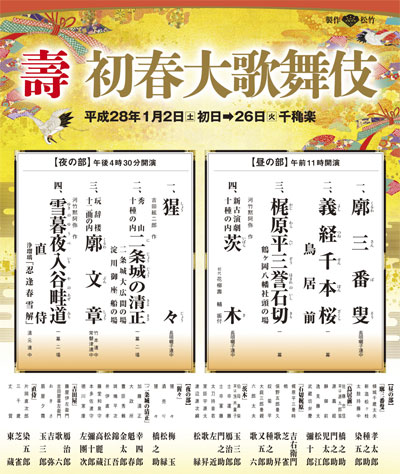| JANUARY 2016 |
|
2 in ďsaka (Sh˘chikuza), 6 shows in T˘ky˘ (Kabukiza, National Theatre, Asakusa K˘kaid˘, Shinbashi Enbuj˘) and 1 tour (Zenshinza)!
|
| Sh˘chikuza (ďsaka) |  |
| Dates | 2 ~ 26 January 2016 (Kotobuki Hatsuharu ďkabuki) Congratulation Early Spring Grand Kabuki |
| MatinÚe | |
| Evening | |
| Casting |
Living National Treasure Sakata T˘jűr˘, Nakamura Senjaku, Kataoka Ainosuke, Ichikawa Chűsha, Nakamura Kazutar˘, Band˘ Takesabur˘, Ichikawa Emiya, Band˘ Shűch˘, Nakamura Kikaku, Nakamura Jűjir˘, Arashi Kitsusabur˘, Kataoka Matsunosuke, Nakamura Kamenoj˘ |
| Comments |
The traditional two programs for the New Year Grand Kabuki at the Sh˘chikuza with a troupe led by Living National Treasure Sakata T˘jűr˘!
|
 |
| Kabukiza (T˘ky˘) |  |
| Dates | 2 ~ 26 January 2016 (Hatsuharu ďkabuki) Early Spring Grand Kabuki |
| MatinÚe |
Yoshitsune Senbon Zakura |
| Evening | |
| Casting |
Living National Treasure Nakamura Kichiemon, Living National Treasure Band˘ Tamasabur˘, Matsumoto K˘shir˘, Nakamura Ganjir˘, Nakamura Hashinosuke, Nakamura Baigyoku, Nakamura Shibajaku, Kataoka Takatar˘, Ichikawa Sadanji, Ichikawa Somegor˘, Onoe Sh˘roku, Band˘ Yajűr˘, Nakamura T˘z˘, Nakamura Karoku, Nakamura Matagor˘, Ichikawa Komaz˘, Ichikawa Monnosuke, Kamimura Kichiya, Matsumoto Kingo, Ichikawa Juen, Sawamura Yoshijir˘, ďtani Keiz˘, Sawamura S˘nosuke, Nakamura Kash˘, Nakamura Matsue, Nakamura Kotar˘, Nakamura Tanenosuke, Matsumoto Kintar˘, Onoe Sakon, ďtani Hirotar˘, Ichikawa Otora, Nakamura Kichinosuke |
| Comments |
The traditional two programs for the New Year Grand Kabuki at the Kabukiza with a troupe led by two Living National Treasures, Nakamura Kichiemon and Band˘ Tamasabur˘!
|
 |
| National Theatre (T˘ky˘) |
| Dates | 3 ~ 27 January 2016 |
| Program |
Koharunagi Okitsu Shiranami (Kogitsune Reiza) |
| Casting |
Living National Treasure Onoe Kikugor˘, Nakamura Tokiz˘, Onoe Kikunosuke, Band˘ Hikosabur˘, Ichikawa Danz˘, Ichimura Manjir˘, Kawarasaki Gonjűr˘, Kataoka Kamez˘, Ichimura Kitsutar˘, Band˘ Kamesabur˘, Band˘ Kametoshi, Nakamura Baishi, Nakamura Mantar˘, Ichimura Takematsu, Onoe Ukon |
| Comments |
Revival in 4 acts (10 scenes) at the National Theatre of Kawatake Shinshichi II's drama "Koharunagi Okitsu Shiranami". This drama was successfully revived in January 2002 at the National Theatre.
|
 |
| Shinbashi Enbuj˘ (T˘ky˘) |  |
| Dates | 3 ~ 24 January 2016 (Hatsuharu Hanagata Kabuki) Early Spring Young Actors Kabuki |
| Program |
Sugawara Denju Tenarai Kagami (Kurumabiki) Benten Musume Meo no Shiranami
|
| Casting |
Ichikawa Ebiz˘, Nakamura Shid˘, Ichikawa Ukon, Kataoka Ichiz˘, Ichikawa Unosuke, ďtani Tomoemon, Ichimura Kakitsu, Ichikawa Emisabur˘, Ichikawa Shun'en, ďtani Hiromatsu, Kataoka Takatar˘ |
| Comments |
The traditional Kabuki show for the New Year Young Actors Kabuki at the Shinbashi Enbuj˘ with a troupe led by the young star Ichikawa Ebiz˘.
|
 |
|
|||
| Dates | 2 ~ 26 January 2016 (Shinshun Hanagata Kabuki) New Year Young Actors Kabuki |
||
| MatinÚe |
Otoshidama (Nenshi Goaisatsu) Sannin Kichisa Tomoe no Shiranami Tosae |
||
| Evening |
Otoshidama (Nenshi Goaisatsu) |
||
| Casting |
Nakamura Kinnosuke, Onoe Matsuya, Band˘ Minosuke, Band˘ Shingo, Nakamura Yonekichi, Nakamura Hayato, Nakamura Kunio |
||
| Comments |
The yearly show for young promising actors at the Asakusa K˘kaid˘ in Asakusa, a lively and colorful neighboorhood that keeps the scent of old Edo.
|
||
| Zenshinza Tour | |
| Dates | 13 ~ 31 January 2016 |
| Program | |
| Casting |
Kawarasaki Kunitar˘, Arashi Yoshisabur˘, Fujikawa Yanosuke, Yamazaki Tatsusabur˘, Anegawa Shinnosuke, Matsunami Kihachir˘, Masuki Hiroshi |
| Comments |
A 2-month 34-date (17 in January and 17 in February) tour all over Japan:
|
|
|
| Contact | Main | Top | Updates | Actors | Plays | Playwrights | Programs | Links | FAQ | Glossary | Chronology | Illustrations | Prints | Characters | Derivatives | Theaters | Coming soon | News |